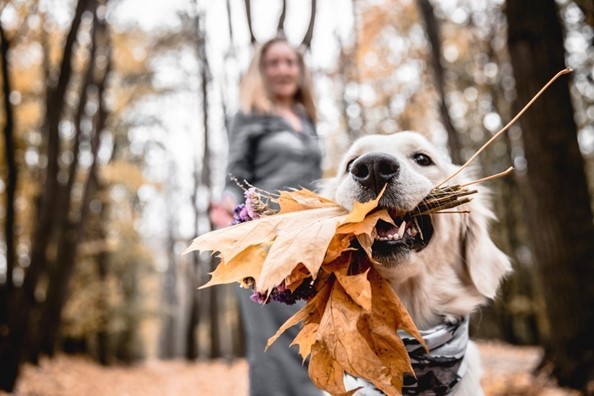Health risks for dogs during the fall season
It's almost autumn again! This means that in a not too long time the leaves will fall from the trees again. For nature lovers, the autumn period may be a beautiful sight, but unfortunately this time is not entirely without dangers for our four-legged friends. In addition to various leaves, the ground is also littered with such things as acorns, chestnuts, holly, pine cones, beechnuts and mushrooms. When your dog eats of these autumn fruits, he can become very sick. In this blog, find out what the health risks are for your dog during the fall season.

Acorns are toxic to dogs
Many dogs enjoy playing with autumn fruits, chewing on them or even eating them. Do not allow this. In fact, many autumn fruits are toxic to dogs, including acorns. Acorns and oak leaves contain the substance tannin, also called tannic acid. Too much tannin can cause intestinal problems, and in severe cases it can even lead to paralysis and kidney failure. Especially unripe, green acorns (and leaves) contain high levels of this toxic substance. Even with ripe acorns and dogs, you must continue to be vigilant. Ripe acorns contain less tannin and are therefore less toxic, but can also definitely cause health problems when eaten in large numbers.
In addition to tannin poisoning, acorns can also cause blockages in your dog's intestines. Such a blockage will require surgical removal in most cases. From this we can conclude that acorns are very unhealthy for our four-legged friends.
Be careful with other autumn fruits
Besides acorns, there are other autumn fruits that are toxic for your dog. Below is an overview of other poisonous autumn fruits:
Chestnuts
An example of a typical poisonous autumn fruit are wild chestnuts and chestnut leaves. Wild chestnuts (and leaves) contain saponins that can cause mucosal irritation and even neurological disorders.
Holly
The red berries and leaves of the holly are also toxic to your four-legged friend. Holly blooms in the fall and winter and contains both tannin and saponin. A dog can experience symptoms such as nausea, vomiting and diarrhea from even a small amount of holly berries. Holly is also poisonous to humans, so be extra careful with it.
Mushrooms
Mushrooms should certainly not be forgotten in the list of poisonous autumn fruits. Mushrooms that are poisonous to humans are also poisonous to dogs. Because it is very difficult to distinguish poisonous mushrooms from non-toxic mushrooms, we recommend that you keep your dog away from these autumn fruits at all. This will prevent your dog from developing unpleasant symptoms such as gastrointestinal or other digestive problems, as well as hallucinations (think barking at movements/noises that we cannot perceive or compulsively chasing its tail and "biting flies"), fever and seizures are symptoms of eating mushrooms. So don't take any chances and stay away from these autumn fruits with your dog.
Pine cones and beechnuts
In addition to the above toxic autumn fruits, there are also autumn fruits that are not toxic to your dog, but are dangerous. These include pine cones and beechnuts. Both do not contain toxins, but they do have sharp splinters and edges. When your dog swallows a pine cone or beechnut, it can cause a lot of damage in the intestines.
What should you do if your dog has eaten an autumn fruit?
Have you seen that your dog has eaten any of the above autumn fruits or is he showing symptoms associated with tannin or saponin poisoning, for example? If so, take action quickly, even if no poisoning symptoms are visible yet. Always contact your veterinarian and when possible, bring the autumn fruit in question or take a picture of the specific autumn fruit, so that the veterinarian can make a proper diagnosis and provide targeted treatment.
How can you prevent your dog from eating fall fruits?
To prevent your dog from taking a bite of (poisonous) autumn fruits, at least don't let him play with acorns, chestnuts, pine cones, beechnuts and mushrooms. The chances that your dog will accidentally swallow something while playing are high. When you see that your dog has an autumn fruit in his mouth, try to exchange it with a reward candy or another snack. Do you have a dog who likes to "snack" on anything on the go? Then choose the safe route and go for one where there are as few fall fruits as possible. Finally, we recommend keeping your dog on a short leash to make it less easy for the dog to eat things off the ground. After all, prevention is better than cure.
Be extra vigilant when walking in a wooded area during the autumn period. Not only pay close attention to your dog, but don't forget to look well around you. After all, autumn is a special season and provides beautiful natural phenomena!
Lots of dogs already enjoy Riverwood every day. Would you also like your dog to feast on our delicious foods and are you curious which variety would suit your dog best? Then answer a few questions here and order an inexpensive sample pack right away.




